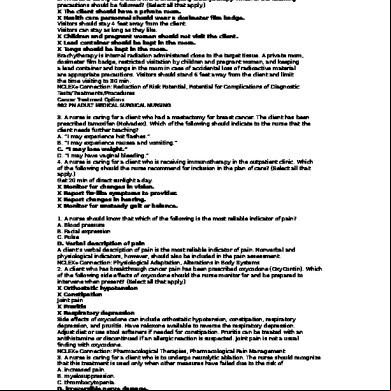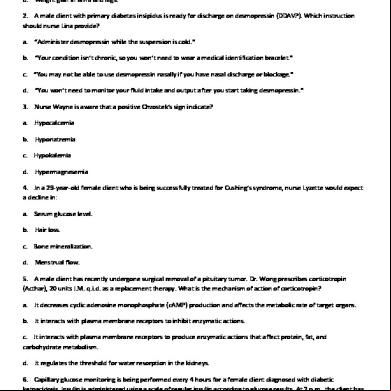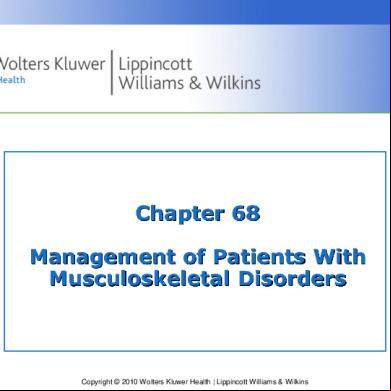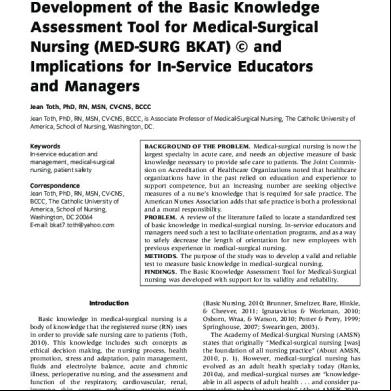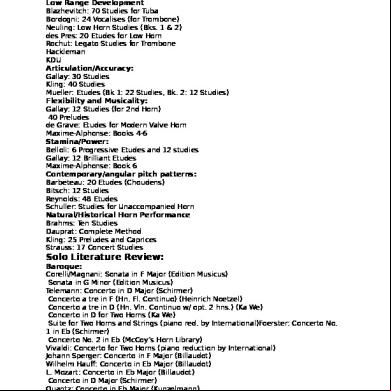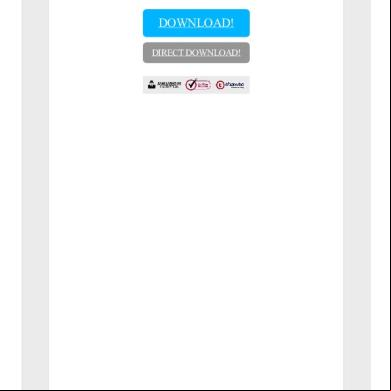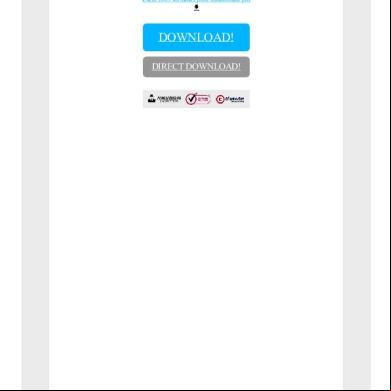Ati Med Surg Questions 32s6r
This document was ed by and they confirmed that they have the permission to share it. If you are author or own the copyright of this book, please report to us by using this report form. Report 2z6p3t
Overview 5o1f4z
& View Ati Med Surg Questions as PDF for free.
More details 6z3438
- Words: 983
- Pages: 3
2. A nurse is caring for a client who is undergoing brachytherapy. Which of the following precautions should be followed? (Select all that apply.) X The client should have a private room. X Health care personnel should wear a dosimeter film badge. Visitors should stay 4 feet away from the client. Visitors can stay as long as they like. X Children and pregnant women should not visit the client. X Lead container should be kept in the room. X Tongs should be kept in the room. Brachytherapy is internal radiation istered close to the target tissue. A private room, dosimeter film badge, restricted visitation by children and pregnant women, and keeping a lead container and tongs in the room in case of accidental loss of radioactive material are appropriate precautions. Visitors should stand 6 feet away from the client and limit the time visiting to 30 min. NCLEX® Connection: Reduction of Risk Potential, Potential for Complications of Diagnostic Tests/Treatments/Procedures Cancer Treatment Options 982 PN ADULT MEDICAL SURGICAL NURSING
3. A nurse is caring for a client who had a mastectomy for breast cancer. The client has been prescribed tamoxifen (Nolvadex). Which of the following should indicate to the nurse that the client needs further teaching? A. “I may experience hot flashes.” B. “I may experience nausea and vomiting.” C. “I may lose weight.” D. “I may have vaginal bleeding.” 4. A nurse is caring for a client who is receiving immunotherapy in the outpatient clinic. Which of the following should the nurse recommend for inclusion in the plan of care? (Select all that apply.) Get 20 min of direct sunlight a day. X Monitor for changes in vision. X Report flu-like symptoms to provider. X Report changes in hearing. X Monitor for unsteady gait or balance. 1. A nurse should know that which of the following is the most reliable indicator of pain? A. Blood pressure B. Facial expression C. Pulse D. Verbal description of pain A client’s verbal description of pain is the most reliable indicator of pain. Nonverbal and physiological indicators, however, should also be included in the pain assessment. NCLEX® Connection: Physiological Adaptation, Alterations in Body Systems 2. A client who has breakthrough cancer pain has been prescribed oxycodone (OxyContin). Which of the following side effects of oxycodone should the nurse monitor for and be prepared to intervene when present? (Select all that apply.) X Orthostatic hypotension X Constipation t pain X Pruritis X Respiratory depression Side effects of oxycodone can include orthostatic hypotension, constipation, respiratory depression, and pruritis. Have naloxone available to reverse the respiratory depression. Adjust diet or use stool softeners if needed for constipation. Pruritis can be treated with an antihistamine or discontinued if an allergic reaction is suspected. t pain is not a usual finding with oxycodone. NCLEX® Connection: Pharmacological Therapies, Pharmacological Pain Management 3. A nurse is caring for a client who is to undergo neurolytic ablation. The nurse should recognize that this treatment is used only when other measures have failed due to the risk of A. increased pain. B. myelosuppression. C. thrombocytopenia. D. irreversible nerve damage. Neurolytic ablation causes permanent nerve destruction. It is usually used only after other
pain relief methods have been unsuccessful. NCLEX® Connection: Reduction of Risk Potential, Potential for Complications of Diagnostic Tests/Treatments/Procedures Pain Management for Clients with Cancer PN ADULT MEDICAL SURGICAL NURSING 993
4. Match the alternative approach to cancer pain in the left column to its description in the right column. B Distraction A. Stimulation of nerve pathways by small needles C Relaxation B. Listening to music A Acupuncture C. Meditation PREOP CARE 1. A 68-year-old client is undergoing an endoscopy, which will require moderate sedation. Which of the following findings in the client’s history indicates the need for further data collection? A. History of gout B. Allergic to bee stings C. History of GI bleed D. Chronic obstructive pulmonary disease 2. An adult woman on a cardiac unit is experiencing episodes of paroxysmal supraventricular tachycardia (PSVT). After performing all other possible interventions, the provider decides to perform cardioversion and to use midazolam (Versed) to relax the client for the procedure. A nurse checks the chart to that all the necessary steps have been completed prior to istering the midazolam. Which of the following findings should the nurse expect to see in the chart? (Select all that apply.) X Signed informed consent X Allergy history X Baseline vital signs and cardiac rhythm X Medications istered X Documentation of the last time the client ate or drank Type and cross match 3. Which of the following preoperative client findings should be reported to the client’s provider? (Select all that apply.) Serum potassium 3.9 mEq/L Serum sodium 145 mEq/L X Serum creatinine 2.8 mg/dL X Prothrombin time of 23 seconds X Blood glucose 235 mg/dL X WBC 17,850/mm3 4. The surgeon is behind schedule and asks the licensed practical nurse (LPN) to complete the consent form. Which of the following statements by the LPN is correct? A. “I can have surgery personnel discuss the procedure with the client.” B. “I can have the RN discuss the surgical complications you foresee.” C. “I can witness the client’s signature on the form.” D. “I can discuss the surgical complications you foresee.”
select all p. 1023 ch. 88 POSTOP Care 1. A client who had a hysterectomy resumed a regular diet earlier in the day. Now the client is reporting nausea and has vomited once. Which of the following actions should the nurse take first? A. Monitor for bowel sounds. B. ister an antiemetic. C. Check the client’s pain level. D. Place the client on NPO status.
Pt. had abd sx 7 days ago. LPN observes serosanguieous drainage. Which
are appropriate actions: X Report the finding to the charge nurse X Reinforce coughing, but avoid forceful coughing. Supine position w/ knees bent is good. X Splint the incision upon mvmt.
3. A nurse is caring for a client who had a mastectomy for breast cancer. The client has been prescribed tamoxifen (Nolvadex). Which of the following should indicate to the nurse that the client needs further teaching? A. “I may experience hot flashes.” B. “I may experience nausea and vomiting.” C. “I may lose weight.” D. “I may have vaginal bleeding.” 4. A nurse is caring for a client who is receiving immunotherapy in the outpatient clinic. Which of the following should the nurse recommend for inclusion in the plan of care? (Select all that apply.) Get 20 min of direct sunlight a day. X Monitor for changes in vision. X Report flu-like symptoms to provider. X Report changes in hearing. X Monitor for unsteady gait or balance. 1. A nurse should know that which of the following is the most reliable indicator of pain? A. Blood pressure B. Facial expression C. Pulse D. Verbal description of pain A client’s verbal description of pain is the most reliable indicator of pain. Nonverbal and physiological indicators, however, should also be included in the pain assessment. NCLEX® Connection: Physiological Adaptation, Alterations in Body Systems 2. A client who has breakthrough cancer pain has been prescribed oxycodone (OxyContin). Which of the following side effects of oxycodone should the nurse monitor for and be prepared to intervene when present? (Select all that apply.) X Orthostatic hypotension X Constipation t pain X Pruritis X Respiratory depression Side effects of oxycodone can include orthostatic hypotension, constipation, respiratory depression, and pruritis. Have naloxone available to reverse the respiratory depression. Adjust diet or use stool softeners if needed for constipation. Pruritis can be treated with an antihistamine or discontinued if an allergic reaction is suspected. t pain is not a usual finding with oxycodone. NCLEX® Connection: Pharmacological Therapies, Pharmacological Pain Management 3. A nurse is caring for a client who is to undergo neurolytic ablation. The nurse should recognize that this treatment is used only when other measures have failed due to the risk of A. increased pain. B. myelosuppression. C. thrombocytopenia. D. irreversible nerve damage. Neurolytic ablation causes permanent nerve destruction. It is usually used only after other
pain relief methods have been unsuccessful. NCLEX® Connection: Reduction of Risk Potential, Potential for Complications of Diagnostic Tests/Treatments/Procedures Pain Management for Clients with Cancer PN ADULT MEDICAL SURGICAL NURSING 993
4. Match the alternative approach to cancer pain in the left column to its description in the right column. B Distraction A. Stimulation of nerve pathways by small needles C Relaxation B. Listening to music A Acupuncture C. Meditation PREOP CARE 1. A 68-year-old client is undergoing an endoscopy, which will require moderate sedation. Which of the following findings in the client’s history indicates the need for further data collection? A. History of gout B. Allergic to bee stings C. History of GI bleed D. Chronic obstructive pulmonary disease 2. An adult woman on a cardiac unit is experiencing episodes of paroxysmal supraventricular tachycardia (PSVT). After performing all other possible interventions, the provider decides to perform cardioversion and to use midazolam (Versed) to relax the client for the procedure. A nurse checks the chart to that all the necessary steps have been completed prior to istering the midazolam. Which of the following findings should the nurse expect to see in the chart? (Select all that apply.) X Signed informed consent X Allergy history X Baseline vital signs and cardiac rhythm X Medications istered X Documentation of the last time the client ate or drank Type and cross match 3. Which of the following preoperative client findings should be reported to the client’s provider? (Select all that apply.) Serum potassium 3.9 mEq/L Serum sodium 145 mEq/L X Serum creatinine 2.8 mg/dL X Prothrombin time of 23 seconds X Blood glucose 235 mg/dL X WBC 17,850/mm3 4. The surgeon is behind schedule and asks the licensed practical nurse (LPN) to complete the consent form. Which of the following statements by the LPN is correct? A. “I can have surgery personnel discuss the procedure with the client.” B. “I can have the RN discuss the surgical complications you foresee.” C. “I can witness the client’s signature on the form.” D. “I can discuss the surgical complications you foresee.”
select all p. 1023 ch. 88 POSTOP Care 1. A client who had a hysterectomy resumed a regular diet earlier in the day. Now the client is reporting nausea and has vomited once. Which of the following actions should the nurse take first? A. Monitor for bowel sounds. B. ister an antiemetic. C. Check the client’s pain level. D. Place the client on NPO status.
Pt. had abd sx 7 days ago. LPN observes serosanguieous drainage. Which
are appropriate actions: X Report the finding to the charge nurse X Reinforce coughing, but avoid forceful coughing. Supine position w/ knees bent is good. X Splint the incision upon mvmt.
